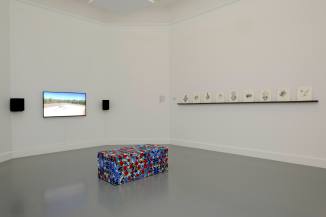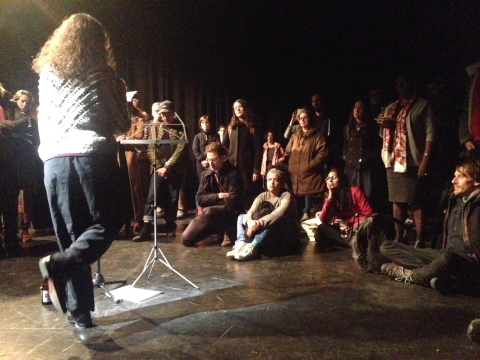Drawing Rights, 2018 is the first conceptual film work by Australian-born, Berlin-based artist/writer Rachel O’Reilly. Collaborating with Pa.LaC.E (Valle Medina and Benjamin Reynolds) who produced the CG visuals, the film uses original graphics generated from 3d risograph drawings, corporate plans, and activist drone footage of fracking wells, to narrate the racism of Australian property laws that precede the ease of ‘unconventional extraction’ in the settler colony. The ‘Torrens Title’ property registration system invented for the colonisation of Australia was the first fully fungible capitalist model of landed property in the world. Invented by Robert Richard Torrens in 1858, a shipping officer with no legal training whatsoever, it based land on the model of autonomous, shipped property. It also removed the common law requirement to survey past histories of ownership at land sales. This meant it was impossible for Aboriginal people to contest the legality of colonisation. Today, the settler’s rights to private property are being toxified by fracking wells, while this most ‘efficient’ registry system has spread rapidly across the British Empire, and is now the dominant land management system globally, used by the IMF since the mid-2000s. The film draws on recent research on Torrens Title (Brenna Bhandar, Sarah Keenan and Renisa Mawani), white possession (Aileen Moreton-Robinson, Goenpul) and ongoing dialogues of The Gas Imaginary project with Gooreng Gooreng elders (esp. Juliri Ingra and Jackie Johnson), environmental and aboriginal activists and historians (esp. Roxley Foley, Gumbaynggirr).

CREDITS
RACHEL O’REILLY with PALACE (Valle Medina and Benjamin Reynolds)
Drawing Rights 2018
Editing: Sebastian Bodirsky
Sound: Tyler Friedman
Advisory: Juliri Ingra (Gooreng Gooreng), Roxley Foley (Gumbaynggirr)
HD Video, colour, stereo, 17.09mins.
Commissioned by Frontier Imaginaries and the Van Abbemuseum.
BIO
Rachel O’Reilly is a Berlin-based artist, writer and curator with a Master in Media and Culture from the University of Amsterdam. She teaches the Seminar ‘At the Limits of the Writerly’ at the Dutch Art Institute’s ‘How to Do Things with Theory’ program. In residence at the Jan van Eyck Academie she developed The Gas Imaginary (2013 – ) using poetry, drawing, film and public lectures to address the install of unconventional gas (fracking) investments in settler colonial space. Rachel was a curator of film, video and new media at the Gallery of Modern Art, Brisbane, including the Fifth Asia Pacific Triennial of Contemporary Art. Curated exhibitions include The Leisure Class (w/ Kathryn Weir), GoMA/Australian Cinematheque, Brisbane; Videoground (Bangkok Experimental Film Festival, Gene Siskel Film Studies Centre, USA), 2008; and (in collaboration) Some Profound Misunderstanding at the Heart of What Is, Hedah Contemporary Art Space, part of Moving Images of Speculation Inlab, Jan van Eyck, 2013-14. More recently she was the Curatorial Advisor to the exhibition and text series Ex-Embassy, Berlin incepted by Sonja Hornung, and co-curator of the Contour Biennale program Planetary Records: Performing Justice between Art and Law with Natasha Ginwala. Her artistic work and research has been presented at the David Roberts Art Foundation, the Museum of Yugoslav History, Tate Liverpool, Qalandiya International, the Van Abbemuseum, and E-flux NY, and is included in the touring/commissioning agency, Frontier Imaginaries. Drawing Rights 2018 is her first experimental film.
PaLaCe – Benjamin Reynolds and Valle Medina
Palace is a collaborative practice that speculates and reacts to spaces of culture, space and economy. Benjamin Reynolds received a diploma with honours from the Architectural Association (AA) in London. He is currently a diploma tutor at the AA. Valle Medina is an architect and a recent graduate (summa cum laude) from the Applied Virtuality Theory Lab, Department of Architecture at the Swiss Federal Institute of Technology in Zurich (ETHZ). They are currently visiting professors at ATTP in TU Vienna. http://palacepalace.com
Exhibition History (artistic work only)
(Group show) A Special Arrow was Shot in the Neck, David Roberts Art Foundation, London, June 2014
(Group show) No Longer at Ease, Institute of Modern Art, Brisbane, May 2016
(Solo show) THE GAS IMAGINARY, Broken norms, unconventional extraction, drawings and other collaborative acts, June 2016
(Group show) Before and After Origins, Qalandiya International, Al Ma’Mal Foundation, Jerusalem October 2016
(Group show) Trademarkings, Van Abbemuseum, Eindhoven, NL, April 2018




